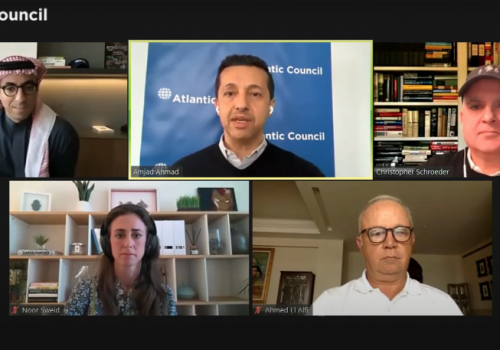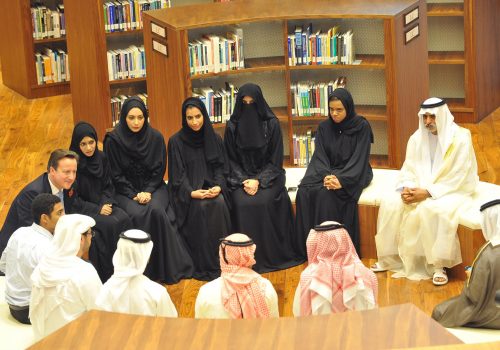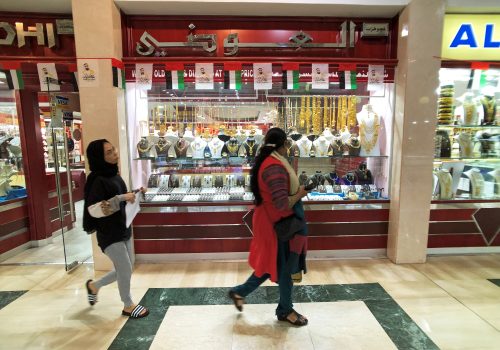Saudi Arabia and the UAE are economic frenemies. And that’s a good thing.
Foreign policy experts tend to sort economic relationships between countries into two categories: allies or enemies. The reality for most economic relationships is often closer to “frenemies,” with simultaneous competition and collaboration. In the business world, we see this quite frequently, especially in the technology sector, and it makes both players stronger in many cases; the ongoing competition between Apple and Microsoft has spurred innovation and more choices for consumers.
Recent tensions between Saudi Arabia and the United Arab Emirates (UAE) have raised questions about the future stability of the Gulf Cooperation Council (GCC). The hysteria is overblown and disregards normal, positive competition between neighboring states, much like Germany and France. What we are witnessing is standard jockeying between two emerging economies working to diversify and grow.
It is essential to put recent events into context. In the past several decades, the UAE rose as a regional hub for business with a progressive social and business environment. Companies interested in the Middle East flocked to the Emirates and attracted top talent from the region and beyond due to the career opportunities and high quality of life. Coinciding with these changes was historically high oil prices after the 2003 Iraq war, rising from mid-$30 per barrel in April 2003 to a peak of over $170 per barrel in June 2008. While oil prices declined in the coming years, especially during the global financial crisis in 2007-2008, they continued to be elevated into the $100 per barrel territory until 2014, when they began their slide to the current levels.
This period led to one of the most significant shifts of wealth from the world to oil-exporting countries, particularly those in the Gulf. The UAE added nearly $300 billion to its gross domestic product (GDP) between 2003-2019, reaching $421 billion in 2019, compared to adding only $87 billion to its GDP from 1987-2003. More importantly, this economic growth was accomplished with oil and gas revenues declining as a percentage of GDP to 30 percent. During 2003-2019, Saudi Arabia added $577 billion to its GDP, reaching $793 billion in 2019, compared to adding only $130 billion to its GDP from 1987-2003. This growth was achieved with oil revenues accounting p to 42 percent of the economy today.
During the 2003-2019 period, trade between Riyadh and Abu Dhabi also increased tenfold from $2.5 billion to $24.5 billion, with the UAE taking the lion’s share with $18 billion of exports to Saudi. The trade between the two countries accounts for a mere 2.18 percent of their combined economies. The UAE represents only 2.9 percent of Saudi exports while Saudi Arabia is 7.22 percent of UAE exports. Though this trade is not inconsequential, it is also not of existential importance for either country.
The primary reason for the trade imbalance is the UAE’s positioning as a regional hub for international and regional firms, especially those targeting its neighbor with the giant economic market that is Saudi Arabia. The UAE’s value proposition worked for decades as dysfunctional regional neighbors, including Saudi Arabia and Iran, struggled for various reasons. Still, it was always a possibility that a sleeping giant like Saudi Arabia would eventually wake up and transform.
The UAE’s diversification efforts to attract international business, including from the United States, Europe, and Asia, have reduced its dependence on GCC neighbors. UAE Prime Minister Sheikh Mohammed Bin Rashid once famously commented that Dubai is not competing with regional cities but rather global ones. In 2019, he celebrated the fact that the UAE had reached the world’s top three hundred index and estimated that its federal and local governments would be in the top ten positions in more than one thousand indicators by 2030.
To suggest that a resurgent Saudi Arabia would negatively impact the UAE is short-sighted and false. Saudi Arabia’s economic awakening will have a long-term positive impact on the UAE and the region. As Saudis become more prosperous, the UAE will be a primary market for investment, trade, and tourism. Additionally, many Emirati companies are making massive investments in Riyadh’s economy, most notably real estate and retail conglomerate Majid Al Futtaim (one of the largest companies in the Middle East), UAE national telecom carrier Etisalat, and Noon, the largest e-commerce company in the Middle East and North Africa (MENA), which is also backed by Saudi Arabia’s Public Investment Fund.
The competition between the two large economies of Riyadh and Abu Dhabi is healthy and will accelerate reform across both economies. There is already positive momentum across the technology sector, where both countries are aggressively moving to ignite their entrepreneurial ecosystems to develop regional “unicorns,” startup companies that have become valued at over $1 billion.
Short-term spats and tension may arise given sudden changes in laws and regulations, such as Riyadh’s recently announced free zone tariffs, but overall policy actions will create a more productive environment for the private sector. Changes in laws and regulations, both positive and negative, are expected as Saudi Arabia builds out relevant government institutions to handle a more agile, capitalist approach. Announcing a broad strategy like Vision 2030 is more straightforward than establishing the suitable government structures to implement it. Abu Dhabi made its share of mistakes as its economy developed. Rapid policy adjustment, specifically after the global financial crisis and the current pandemic crisis, has helped maintain momentum.
Riyadh, likewise, will go through fits and starts as it finds its economic footing, but there is clear positive change. Several of my recent discussions with entrepreneurs expanding into Saudi Arabia from the UAE and Jordan indicate the embrace of a pro-business, pro-growth agenda.
Abu Dhabi is comfortably ahead in its economic development, with Riyadh playing catch up, and it will maintain its lead for some time to come. As both countries continue their economic transformations, fierce and, at times, destructive competitive behavior is expected. A tug of war on headquarters misses the more significant point that most companies seeking to scale in the Middle East must target the wider region, especially the vast Saudi economy. Regardless of where companies are headquartered, Saudi Arabia and the UAE will be essential markets to increase investment, revenues, and employees.
Moves that further complicate regional integration will negatively impact private sector development and the ability of both countries to develop multi-national business champions that can attract investment, drive employment, and increase productivity. In addition, further hindering the ability for companies to scale regionally will negatively impact the entrepreneurial ecosystem both Riyadh and Abu Dhabi are eager to develop. The region has not attracted large pools of international capital due to the operational complexity and scaling challenges for most businesses. The best way to attract capital is to offer international investors a larger market for local companies to scale.
Ultimately, Saudi Arabia and the UAE must realize that it is not a zero-sum game and mutual benefit can be achieved. While they continue their healthy competition, policy coordination can further advance their national interests. The key to mutual benefit will be finding areas of cooperation and tighter integration. Three specific ideas can accelerate their respective visions for the future:
- Infrastructure partnerships: Cooperation on large-scale infrastructure projects in food and agriculture, renewable energy, and transportation would achieve mutual national interests in food security, power generation, and climate change while reducing the cost burden on individual countries and attracting large pools of international capital. Such projects have the potential to increase job growth, drive innovation, and support related small-and-medium businesses.
- Regional growth technology fund: While each country has individually expanded programs to fund startups, growth capital is lacking for later-stage startups to scale effectively. Cooperating on a regional fund to finance successful startups to become multi-national companies that drive local employment, research and development, and support local small and medium enterprises would pay significant dividends in GDP growth, reducing unemployment, increasing productivity, and driving other startups. The fund would complement the local venture capital industry, helping to boost their most successful startups. Creative fund structures can provide access to high-growth private technology companies for local retail investors and large international investors. Both countries have invested in Softbank’s Vision Fund, so why not combine resources for a MENA Vision Fund?
- Investment and digital policy coordination: The rise of e-commerce, remote work, and fintech has the potential to expand trade opportunities in goods and services between the two countries and beyond. One example already underway is Project Aber, which Saudi Arabia and the UAE launched in 2019 to explore the feasibility of creating a cross-border digital currency. Developing working groups specifically amongst investment promotion agencies and digital development agencies will create a platform to brainstorm, which should lead to other mutually beneficial policy coordination to ignite the development of the regional digital economy and further spur international investment.
Both Riyadh and Abu Dhabi have wisely made the economy the focal point of their strategies for the future, as evidenced by national policy changes and a reduction in foreign adventures. Ending the Qatar blockade, and opening a dialogue with adversarial neighbors like Iran and Turkey is linked to long-term economic ambitions. Reducing the temperature in the region has a clear economic policy objective of preserving capital and attracting foreign investment. However, this is par for the course. Competing effectively against one another while cooperating to increase the size of the pie will lead to more extraordinary results.
Amjad Ahmad is director and resident senior fellow of empowerME at the Atlantic Council’s Rafik Hariri Center for the Middle East. Follow him @AmjadAhmadVC.
Image: Abu Dhabi's Crown Prince Sheikh Mohammed bin Zayed al-Nahyan meets with Saudi Crown Prince Mohammed bin Salman during the Saudi-UAE Summit in Jeddah, Saudi Arabia, June 6, 2018. Picture taken June 6, 2018. Bandar Algaloud/Courtesy of Saudi Royal Court/Handout via REUTERS


